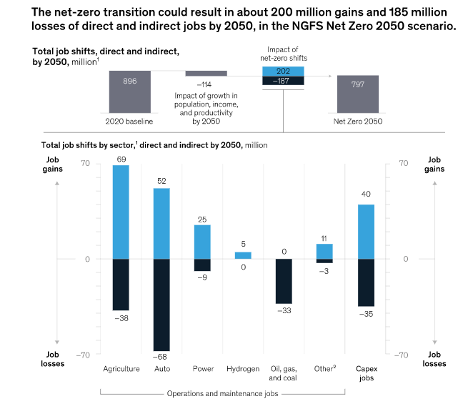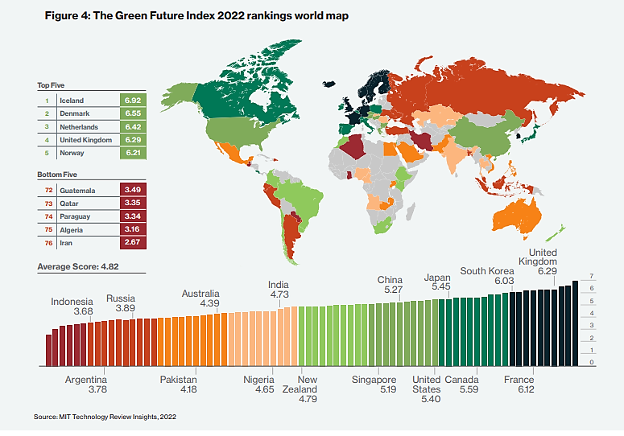-
The world is on the verge of an economic super-cycle, driven by the need to precipitously invest in the technology, infrastructure and resources which can contribute to stemming the rapid rise in global temperatures – and consequent economic, environmental and social destruction.
But just what that cycle will look like is, of course, impossible to predict. Just consider how few people understood the impact of the internal combustion engine on the horse and cart or the personal computer on our social networks.
“This cycle will be rich in carrots but it’s also not short of sticks, from both regulators and the providers of capital to investors and banks.”
There’s been plenty of guesses at the scale of the super-cycle however, some more rigorous than others.
According to McKinsey & Co “this wholesale shift toward institutions and projects that emit minimal greenhouse gases (GHGs) may create the largest reallocation of capital in history”.
The consultancy estimates nearly two thirds of annual, global capital spending currently goes into high-emissions assets but if the world is to reach net zero carbon emissions by 2050, this pattern would reverse with more than two thirds of capital outlays instead spent on low-emissions assets.
That would translate to $US9.2 trillion in annual average spending on physical assets - $US3.5 trillion more than today – and equivalent to half of global corporate profits and one-quarter of total tax revenue in 2020, according to McKinsey.
{CF_IMAGE}
Carrots and sticks
At this bank, chief executive Shayne Elliott has spoken of the super cycle as one of the key growth opportunities, particularly for its institutional business, highlight the electrification of transport, the commercialisation of hydrogen and the financing of energy efficient buildings among a multitude of sectors.
This cycle will be rich in carrots but it’s also not short of sticks, from both regulators and the providers of capital to investors and banks.
More and more major investors are making this clear. For example, at its latest annual meeting, Goldman Sachs Asset Management announced it would vote against audit committee members at companies that do not disclose material greenhouse gas emissions data or have failed to make progress to do so. Other major investors, including most notably BlackRock and State Street, have also been increasing pressure on companies to bolster their ambitions and disclosure around net zero targets.
Meanwhile, regulators and supervisors around the world continue to ratchet up requirements for investors, financial intermediaries and companies to disclose both their own emissions and the risks to their business from climate change.
Most recently, and notably, the US Securities and Exchange Commission (SEC) proposed rules requiring public companies to disclose extensive climate-related information in their SEC filings. These rules would mandate disclosure of climate-related risks “reasonably likely to have a material impact on a public company’s business, results of operations, or financial condition”. The SEC also want to know greenhouse gas (GHG) emissions associated with a public company that includes, in many cases, an attestation report by a GHG emissions attestation provider; and climate-related financial metrics to be included in a company’s audited financial statements.
{CF_IMAGE}
Proactive change
The official sector is also being proactive, a critical factor if the necessary investment in achieving net zero is to be reached.
For example, the Bank for International Settlements (BIS) has launched green bond funds dedicated to helping finance investments in green projects in the Asia and Pacific region.
The latest Asian Green Bond Fund joins two other green bond funds issued by the BIS since 2019. Together, the funds will manage some $US3.5 billion in green bonds for central banks and other official sector investors.
The BIS said the new fund offers central banks, both in Asia and beyond, opportunities to invest in high-quality bonds issued by sovereigns, international financial institutions and corporates that comply with strict international green standards.
“These bonds help finance environmentally friendly projects in areas such as renewable energy production and energy efficiency in the Asia and Pacific region,” the bank said.
There is no doubt much uncertainty exists in the financing of a carbon reduction super cycle – including rigorous and consistent standards of reporting and investment. Equally though such a cycle requires innovation. Up to a point, those who adhere to a Panglossian “technology will save us” view of the world are right. But what technology?
The latest Green Future Index 2022 report by MIT Technology Review Insights provides insight into just one aspect of this challenge. It found the Asian region is well placed to generate the tech innovation required for a sustainable economy (although unfortunately Australia lags).
Europe continues to lead the way overall but in Asia, South Korea leads in patent creation relative to gross domestic product (GDP) and China and Japan lead in absolute patent numbers. South Korea produced 700 patents per billion dollars of GDP, while Japan produced 340, China 267 and the US 68.
{CF_IMAGE}
Climate laggards
South Korea also topped the “green society” category which incorporates sustainability measures such as greening buildings, recycling and consuming less meat and dairy products.
Australia however lags and its overall rating declined from 35 to 52 in the latest report, dropping it to the “20 countries that are making slow and uneven progress or commitment toward building a green future” category.
“As with the 2021 edition, many of the Climate Laggards have economies anchored to fossil fuel or resource extraction industries,” the report found. “These include countries that have been actively investing in technologies and industrial transition programs to move away from hydrocarbon businesses (such as the United Arab Emirates or Saudi Arabia) as well as others that remain committed to extractive industries as part of their economic development (Mexico and Australia).”
Overall though, the report was modestly optimistic: “There has also been an incredible ramp-up in the investment in renewable energy (accounting for more than 70 per cent of all new power generation in 2021) and many of the world’s leading nations—including some of its largest polluters— committed to firm dates to achieve carbon neutrality. Our collective efforts to establish a green future are inexorably (if perhaps more moderately than hoped for) gathering momentum.”
McKinsey’s analysis adds some financial incentives to that momentum.
“We estimate burgeoning demand for net-zero offerings would create unprecedented opportunities: 11 value pools could generate more than $US12 trillion of annual sales by 2030,” the firm found. “These include transport ($US2.3 trillion to $US2.7 trillion per year), buildings ($US1.3 trillion to $US1.8 trillion), and power ($US1.0 trillion to $US1.5 trillion).”
That’s a super cycle.
Andrew Cornell is Managing Editor of bluenotes
The views and opinions expressed in this communication are those of the author and may not necessarily state or reflect those of ANZ.
-
-
-
anzcomau:Bluenotes/social-and-economic-sustainability,anzcomau:Bluenotes/global-economy
Super cycling to a sustainable future
2022-04-27
/content/dam/anzcomau/bluenotes/images/articles/2022/April/AC_Column.png
EDITOR'S PICKS
-
ANZ CEO Shayne Elliott discusses the growth and investment opportunity in the transition to a lower carbon economy.
4 March 2022 -
Trillions of dollars will be needed to even rein in carbon emissions – and that’s more an opportunity than a cost.
9 February 2022



